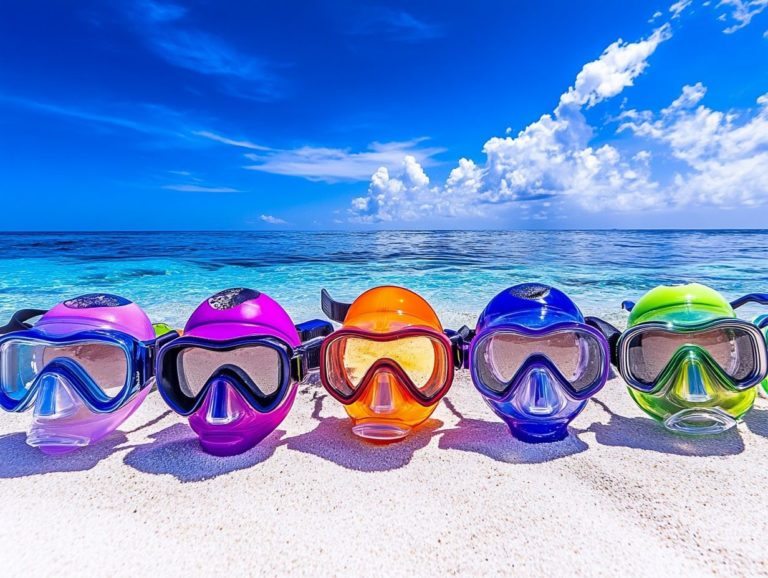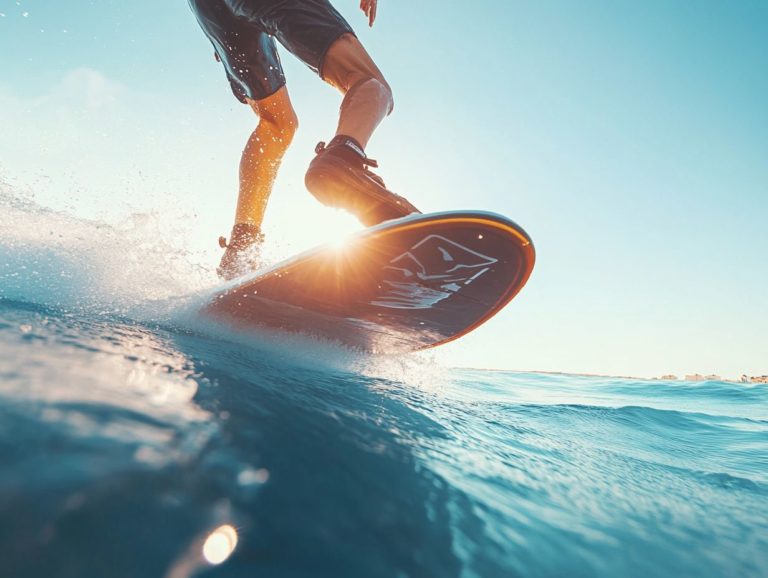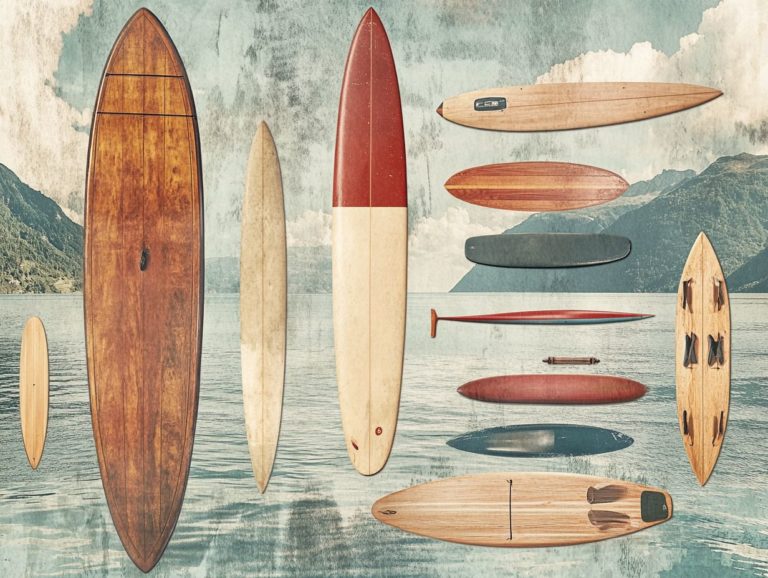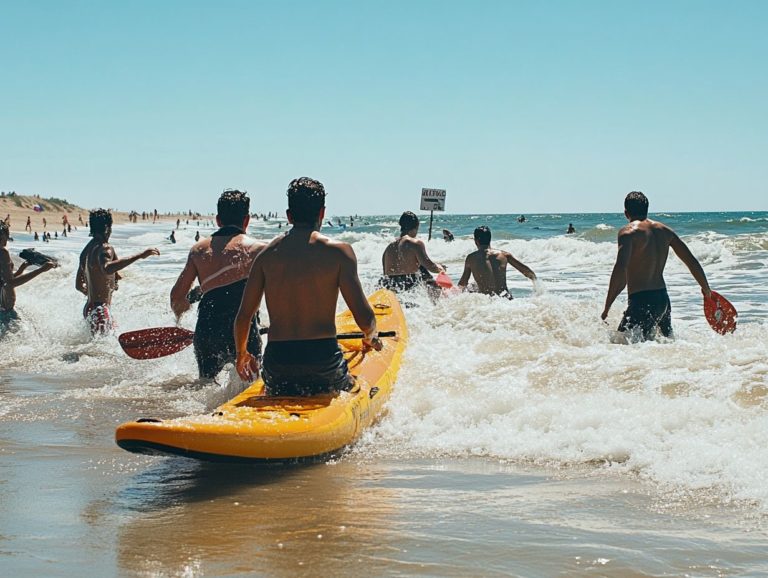5 Must-Have Accessories for Surfing
Surfing transcends the mere thrill of riding waves; it s an immersive experience that hinges on having the right gear to enhance both enjoyment and safety. Whether you re a seasoned expert or embarking on your surfing journey, the right accessories can profoundly impact your experience.
Here are five essential items every surfer should have:
- Surfboards
- Wetsuits
- Leashes
- Wax
- Sunscreen
- Surf fins
You will also receive guidance on selecting the perfect options tailored to your unique style and needs, including recommendations for surfing accessories and post-surf care. Get ready to take your surfing to the next level!
Contents
- Key Takeaways:
- 1. Surfboard
- 2. Wetsuit
- 3. Leash
- 4. Wax
- 5. Sunscreen
- Explore Surfboards and Accessories!
- How Do I Choose the Right Size and Shape for My Surfboard?
- What Are the Different Types of Wetsuits?
- How Do I Choose the Right Thickness for My Wetsuit?
- What Are the Different Types of Leashes?
- How Do I Choose the Right Length and Strength for My Leash?
- What Are the Different Types of Wax?
- How Do I Choose the Right Type of Wax for My Surfboard?
- Why Is Sunscreen Important for Surfing?
- How Do I Choose the Right Sunscreen for Surfing?
- What Other Accessories Can Enhance My Surfing Experience?
- Frequently Asked Questions
Key Takeaways:
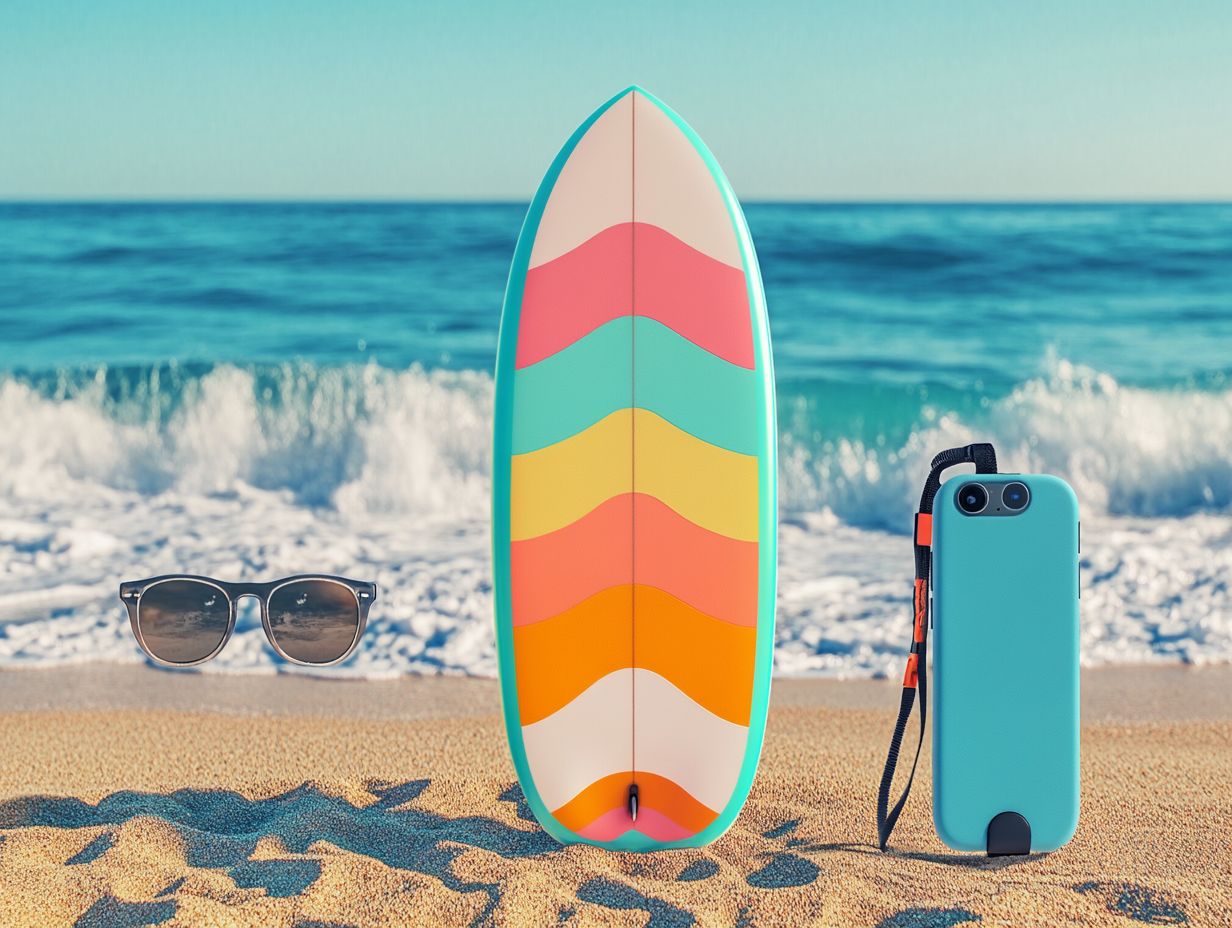
Invest in a high-quality surfboard for better performance and durability. Choose a wetsuit that fits well and keeps you warm in cooler waters. A sturdy leash is essential for safety and convenience while surfing.
1. Surfboard
The surfboard is your ultimate companion in the exhilarating world of surfing, capturing the essence of adventure and excitement that comes with riding the waves at legendary spots like Rockaway Beach in New York.
Whether you’re just starting with surf lessons or you re a seasoned pro aiming to elevate your performance, choosing the right surfboard is very important for a truly enjoyable experience on the water. You ll want to take into account factors such as size, shape, and the types of waves you’ll face, as these elements can dramatically affect your surfing experience.
Different surfboard types cater to various styles and conditions, each with its own unique advantages:
- Shortboards are built for high performance, allowing for rapid maneuvers on steep waves, making them the go-to choice for experienced surfers tackling larger waves.
- Longboards offer stability and ease of paddling for beginners, encouraging a relaxed vibe that’s perfect for smaller waves.
- Fish boards, with their wider tails, are responsive in choppy conditions, ideal for those seeking a fun and dynamic ride.
- Funboards find the sweet spot between short and longboards, making them versatile enough for surfers at every skill level.
Don t forget about essential accessories like surfboard leashes, which are vital for safety, preventing your board from disappearing during wipeouts. Additionally, fins enhance your maneuverability. Brands like Patagonia provide top-notch surf gear that guarantees durability and comfort, supporting you no matter the conditions you face.
2. Wetsuit
A wetsuit is a critical part of your surfing gear, especially when you’re ready to take on the cooler waters at Rockaway Beach. Made from a stretchy material used in wetsuits, neoprene comes in various thicknesses, with options like the premium 2mm providing the perfect balance of flexibility and insulation.
Selecting the right wetsuit not only elevates your surfing experience but also shields you from surf rash a skin irritation caused by friction with the board and the chill of the ocean.
As a surfer, you have various styles at your disposal, each tailored to specific conditions and temperatures. Full suits are your go-to for frigid waters, offering complete coverage and warmth. For milder climates, spring suits deliver versatility without compromising comfort. When the sun is shining and the water feels inviting, shorties with their short sleeves and legs are perfect for allowing a bit of exposure.
The fit of your wetsuit is crucial; an ill-fitting suit can restrict your movement and lead to discomfort, which is the last thing you want while catching waves. Brands like Patagonia are renowned for crafting wetsuits that seamlessly blend functionality with eco-friendly materials, ensuring you can perform at your best while making choices that feel good for both you and the planet.
Check out the latest models and find the perfect fit for your next adventure!
3. Leash
The surfboard leash is a critical accessory that links you to your board. It provides safety and ease of retrieval when you wipe out or paddle back to shore.
In the world of surfing, a reliable leash can make the difference between losing your board to the open water and maintaining control. This makes it essential gear for both novices and experienced surfers.
When selecting a leash, it’s vital to consider the appropriate length and strength based on your surfboard dimensions and the wave conditions you’ll encounter. This ensures all your surfing accessories are up to par, including the top survival gear accessories you need.
Among the various leash types, coiled leashes present a distinct advantage. They minimize drag in the water, making them ideal for smaller waves or when maneuverability is paramount. Conversely, straight leashes offer more length, which is perfect for larger boards and more powerful waves.
Adjustable leashes grant you the flexibility to modify the leash length based on your preferences or changing surf conditions. As you consider your options, reflect on your surfing style those who ride prone may gravitate toward a coiled leash, while stand-up surfers might opt for a straight leash for enhanced stability.
Renowned brands like Dakine, Ocean & Earth, and Creatures of Leisure consistently provide high-quality options tailored to diverse surfing needs.
4. Wax
Don t underestimate surf wax; it s a game-changer for any surfer! It provides the grip and traction needed on your surfboard, allowing you to maintain control while carving through those waves.
By applying the right type of surf wax tailored to your local conditions, you can elevate your performance. This gives you the confidence to tackle bigger challenges at spots like Rockaway Beach.
Surf wax comes in various compositions and temperature ratings, which help you customize your board for optimal grip. Whether you re braving warm tropical waters or cooler climates, using the right wax is crucial.
For example, warm water wax is softer and stickier, perfect for sun-soaked sessions, while cold water wax is firmer, ensuring you stay anchored in chilly conditions. It typically comes with temperature ratings, simplifying the decision-making process.
To get started, apply a base coat with a circular motion to create a textured surface. Then, layer on additional wax for that extra grip. Regular maintenance is crucial; old or worn wax can hinder your performance. Make it a habit to remove any excess and reapply as necessary!
5. Sunscreen
Sunscreen is an absolute essential in your surfing gear! It offers vital protection against harmful UV rays while you relish the waves under the sun. By opting for high-quality sunscreens from brands like Kinfield and Supergoop, you can prevent surf rash and skin damage.
Apply sunscreen often to protect your skin from harmful UV rays! Remember, especially at lively surf spots like Rockaway Beach, where sun exposure can be intense.
Choosing the right sunscreen isn’t just about slathering on some cream; it’s about understanding SPF ratings, which show how long the product protects you from UVB rays that can lead to sunburn. Opting for water-resistant formulas is crucial, particularly if you re spending extended time in the water.
Choosing eco-friendly options also helps protect marine life an important consideration for anyone who shares a passion for surfing. Additionally, remember that staying hydrated is just as vital! Dehydration can hinder your performance in the water and make your skin more susceptible to sun damage.
So, pairing effective sun protection with ample hydration, courtesy of your Hydro Flask, is the key to enjoying your surfing adventures safely and to the fullest.
Explore Surfboards and Accessories!
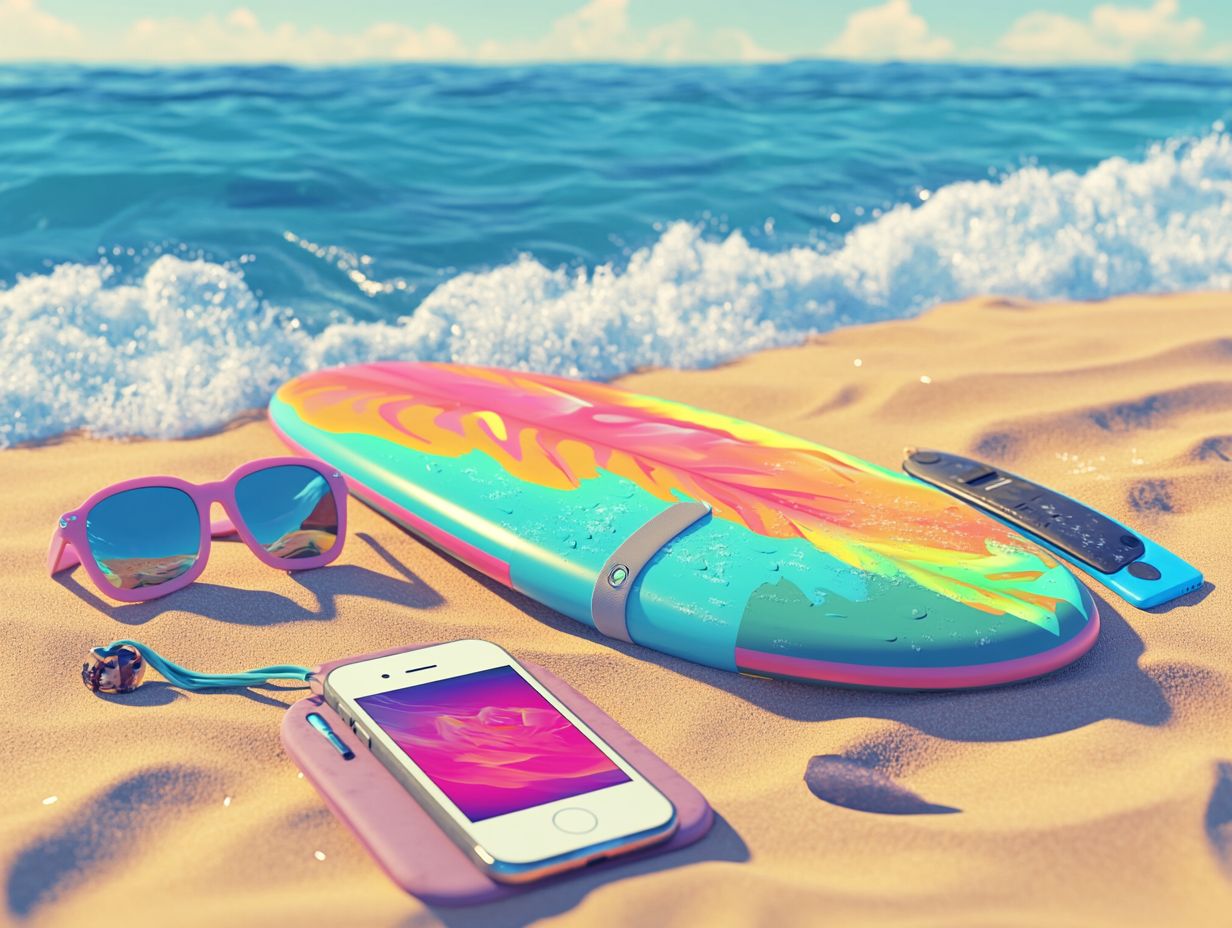
Choosing the right surfboard is crucial for all skill levels. Each design has unique benefits tailored to different surfing styles and wave conditions.
You can also consider hybrid designs like fish and funboards that blend versatility and excitement. These are great options if you’re eager to experiment at popular surf spots like Rockaway Beach.
Every surfboard type is carefully designed with shapes and sizes that match your experience and the ocean s temperament. Shortboards, typically ranging from 5’6″ to 6’2″, are narrower and built for agility, making them ideal for advanced surfers who tackle steep, powerful waves.
On the flip side, longboards often exceed 9 feet, featuring a wider nose and rounded tail that provide a smoother ride for novices in smaller, mellow waves.
If you re still finding your footing, funboards can be your best friend. They blend elements of both short and longboards, serving as the perfect solution for building confidence in a variety of conditions.
Think quickly about what you love! Consider your skill level, the types of waves you plan to ride, and your personal preferences whether you lean towards speed, maneuverability, or stability.
How Do I Choose the Right Size and Shape for My Surfboard?
Choosing the right size and shape for your surfboard is pivotal in enhancing your surfing experience; it directly influences your performance on the waves. Factors like your weight, height, skill level, and the type of waves you ll be riding play a crucial role in determining the optimal dimensions of your board.
By understanding the various shapes like a wider nose for stability or a tapered tail for maneuverability you can make an informed decision that aligns perfectly with your surfing style.
To accurately gauge the ideal board size, think about how much space your body takes up compared to the surfboard’s volume. A board that s too small may hinder your performance in larger swells, while one that s too large could feel cumbersome in smaller, more technical waves.
How different board shapes can optimize your ride is also important. For instance, a fish design excels in small, mushy waves due to its increased surface area, while a shortboard typically shines in overhead conditions because of its speed and responsiveness.
Experimenting with various shapes based on local wave characteristics can lead to a more enjoyable surfing adventure, making each session on the water uniquely thrilling.
What Are the Different Types of Wetsuits?
Wetsuits come in a variety of styles full suits, spring suits, and shorties each tailored for specific water temperatures and surfing conditions. Choosing the right wetsuit isn t just about staying warm; it s about giving yourself the flexibility to excel while riding those waves.
Understanding the distinct characteristics of each type can dramatically elevate your comfort and performance during your surfing adventures, whether you’re at Rockaway Beach or somewhere more exotic. For those into sailing, be sure to check out the 5 must-have items for your sailing gear to enhance your experience.
Full suits are your go-to for colder environments, crafted from thicker neoprene to deliver exceptional insulation. Spring suits provide lighter protection, making them perfect for milder conditions. If you’re hitting warmer waters, shorties offer minimal coverage and allow for maximum freedom of movement.
The material you choose is crucial for both warmth and durability. Opting for high-quality neoprene can enhance flexibility and extend the lifespan of your wetsuit.
Once you’ve made the right choice, proper care is essential. Remember to rinse your wetsuit in freshwater after each use, avoid prolonged sun exposure, and store it flat or hung to prevent creasing. By maintaining your wetsuit regularly, you’ll ensure that this vital gear stands the test of time in any aquatic environment.
How Do I Choose the Right Thickness for My Wetsuit?
Choosing the right thickness for your wetsuit is essential. It directly influences your comfort and performance while surfing in various water temperatures. Thicker wetsuits offer more insulation but can limit your movement. Thinner options provide greater flexibility, albeit at the expense of warmth. By understanding the water temperature and weather conditions at locations like Rockaway Beach, you can make a well-informed choice tailored to your surfing needs.
Wetsuit thickness generally ranges from 2mm to 6mm. Each thickness is designed for specific temperature ranges. For instance, a 2mm wetsuit is perfect for warm waters above 70 F. It allows for agile movements without feeling restricted. Conversely, a 4mm suit is typically ideal for cooler conditions around 60 F to 70 F. It strikes a nice balance between warmth and comfort. If temperatures dip below 60 F, you may need to opt for a thicker 5mm or even 6mm wetsuit to ensure adequate insulation.
When making your selection, consider not just the water temperature, but also your activity level and personal tolerance to cold. These factors significantly influence how effectively a wetsuit keeps you warm while allowing for necessary movement. Don t wait! Choose the right wetsuit thickness today to enjoy your time on the waves!
What Are the Different Types of Leashes?
Surfboard leashes come in various styles, including coiled and straight options. Each is meticulously designed for specific purposes that keep you connected to your board. A great leash boosts your safety and enhances your surfing fun! It makes it easier to get your board back after a wave while minimizing the risk of losing it. Understanding the differences between leash types helps you select the right one for your surf adventures.
Coiled leashes compress when not in use and excel at reducing drag in the water. They are compact, which keeps them from tangling, making them perfect for smaller waves and crowded surf spots. In contrast, straight leashes offer more length and flexibility. They are ideal for tackling larger waves and powerful conditions where extra distance is essential.
When choosing between the two, consider your usual surf conditions, style, and personal preferences. Surf conditions refer to the size and power of the waves. A well-selected leash can significantly enhance both your performance and safety while you’re out on the water. Additionally, if you’re planning a kayaking trip, don’t forget to check out these must-have items for kayaking trips.
How Do I Choose the Right Length and Strength for My Leash?
Choosing the right length and strength for your surfboard leash is crucial. It ensures that it aligns perfectly with your surfing style and board type. A leash that’s too short won t give you the necessary distance for safe surfing. Meanwhile, one that s excessively long can turn into a tangled mess, making your session more frustrating than fun. The leash s strength should correspond to the size and type of surfboard you re using, guaranteeing reliable performance when you re out there catching waves.
Consider factors like your height and the dimensions of your surfboard. They play a significant role in making the right choice. For example, if you re taller, a longer leash might be your best bet. It offers greater maneuverability without the risk of dragging your board. On the other hand, shorter boards typically do well with shorter leashes to avoid unnecessary length that can create obstacles.
Don’t overlook the leash’s strength ratings; they indicate how much force the leash can handle without breaking. Generally, thicker leashes are crafted for larger boards, delivering the durability necessary to handle the demands of bigger waves and more aggressive riding. Therefore, it’s essential to choose wisely, keeping your personal preferences and board specifications in mind. For more insights, check out these 5 tips for beginner surfers, and now you’re ready to choose your ideal wetsuit and leash for an unforgettable surf experience!
What Are the Different Types of Wax?
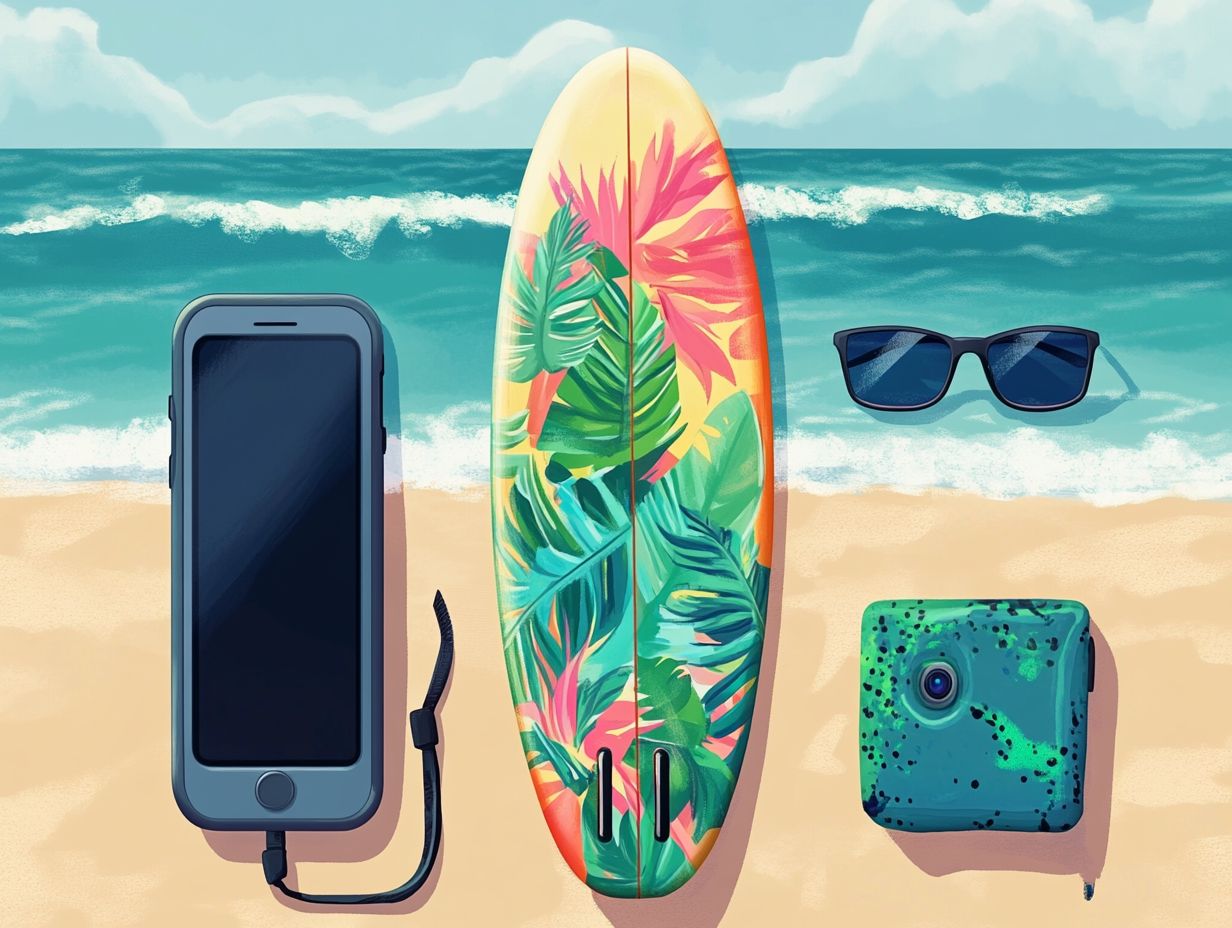
Surf wax comes in various types, each crafted for specific temperature ratings and conditions. It s an essential part of your surfing arsenal. Whether you’re riding waves in warm climates or tackling cooler waters, applying the right wax is key to maintaining grip and performance on your surfboard.
Understanding the nuances of the different surf wax types can truly elevate your surfing experience and keep you gliding smoothly.
Temperature-specific waxes are expertly designed to provide optimal traction. For instance, warmer water calls for a softer wax that ensures ideal stickiness, while cooler water necessitates a harder wax for a firmer grip.
Before applying, take a moment to clean your board thoroughly. Remove any residual wax or dirt to enhance adhesion. Regular maintenance like reapplying after each session and checking for wear can significantly extend the life of the wax and enhance your performance on the waves.
Knowing how to choose and apply the right wax boosts your confidence and enriches your overall surfing experience.
How Do I Choose the Right Type of Wax for My Surfboard?
Choosing the right type of wax for your surfboard is crucial for achieving optimal grip and performance while you ride the waves. Factors like water temperature, surfboard material, and your personal preferences play significant roles in determining which wax suits your needs best.
When you re surfing in warmer waters, a softer wax is typically the way to go, while harder waxes shine in cooler climates. The type of surfboard you ride whether it s a longboard or a shortboard can also influence your wax choice, as different designs require varying levels of traction.
Your personal preferences, such as how sticky you like the wax or how easy it is to apply, should definitely factor in.
Once you ve chosen the right wax, applying it correctly is essential. Start with a base layer to build up traction, and then add top coats for maximum grip. Regular maintenance, including scraping off old wax and reapplying as necessary, will ensure you re getting the best performance as you conquer those waves.
Why Is Sunscreen Important for Surfing?
Never hit the waves without sunscreen! It s essential for protecting your skin while you revel in the sun and surf at stunning spots like Rockaway Beach. The right sunscreen doesn t just guard against harmful skin damage; it also helps mitigate the risk of surf rash, a rash caused by friction from the surfboard, allowing you to concentrate fully on your performance in the water.
With extended exposure to the sun, you face significant risks such as sunburn, premature aging, and even the potential for skin cancer. To tackle these dangers, it s critical to select a sunscreen that offers protection from both UVA and UVB rays. Opting for water-resistant formulations is especially advantageous, as they remain effective even when you’re splashed by waves or fully submerged.
Aim for products with an SPF of at least 30, and remember to reapply every two hours or immediately after swimming. Make sunscreen your first priority for those long beach days! By making sunscreen a priority, you can relish the ocean while effectively minimizing your skin-related health risks.
How Do I Choose the Right Sunscreen for Surfing?
Choosing the right sunscreen for surfing is essential. Focus on SPF ratings, water resistance, and how it interacts with your skin. You want a sunscreen that lets you relish every moment in the water, free from the nagging concerns of sunburn or skin irritation, especially during lengthy surf sessions.
Investing in high-quality sunscreens tailored for active lifestyles can elevate your surfing experience while keeping your skin safe. Additionally, if you’re planning to windsurf, be sure to check out the top 10 essential items for windsurfing. Consider local conditions, such as UV intensity and the time you’ll spend under the sun, to select a product that truly meets your needs.
It’s wise to opt for a broad-spectrum sunscreen with an SPF of at least 30 to shield yourself from both UVA and UVB rays. When applying, make sure to cover all exposed skin evenly don t forget often-overlooked spots like your ears and the back of your neck.
For maximum effectiveness, reapply every two hours, or more frequently if you’re swimming or sweating. This way, you can enjoy the waves worry-free.
What Other Accessories Can Enhance My Surfing Experience?
Along with your must-have surfboard, wetsuit, and leash, several accessories can significantly enhance your surfing experience. Consider items like a Hydro Flask to keep you hydrated and plush beach towels for added comfort. Surf utility boxes are great for neatly storing your gear while you bask in the sun.
Investing in top-notch surfing accessories will take your experience to the next level! Surf wax and traction pads are also crucial; they help you maintain a solid grip on your board. If you’re planning to explore underwater, don’t forget the 5 must-have items for snorkeling. Opt for eco-friendly brands like Sticky Bumps and Creatures of Leisure to marry your surfing passion with a commitment to reducing environmental impact.
Don t underestimate the value of a high-quality surf hat or a UV-protective rash guard; they provide essential protection against sunburn and keep you comfortable during long sessions. By choosing sustainable options from companies like Patagonia, you can align your love for surfing with a commitment to preserving our oceans and beaches.
These thoughtful accessories not only enhance your enjoyment but also promote a responsible and mindful surfing lifestyle.
Frequently Asked Questions
What are the 5 must-have accessories for surfing?
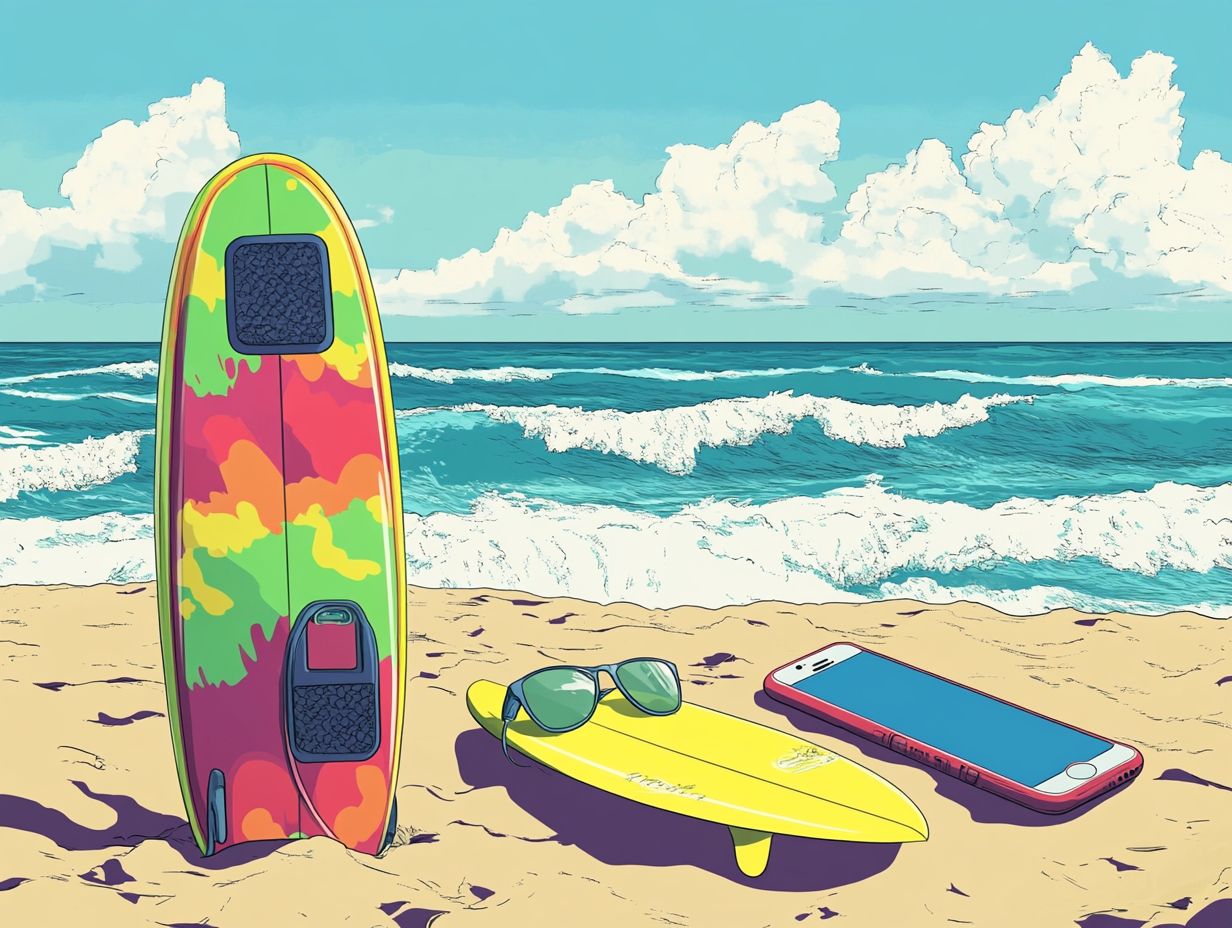
The 5 must-have accessories for surfing are a surfboard, wetsuit, leash, wax, and fins.
Is a surfboard the most important accessory for surfing?
Yes, a surfboard is the most important accessory for surfing. It is necessary for riding waves.
Do I need a wetsuit for surfing?
It depends on the water temperature. If the water is cold, a wetsuit is needed to keep you warm and protect your body.
Why is a leash important for surfing?
A leash is important for surfing as it keeps your surfboard attached to you. This prevents it from getting lost or hitting other surfers in the water.
What type of wax should I use for surfing?
The type of wax used for surfing depends on the water temperature. Hard wax is used for warm water, while softer wax is used for colder water.
Are fins necessary for surfing?
Yes, fins are necessary for surfing. They provide stability and help with maneuvering on the waves.

